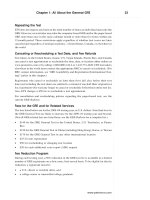The JSP Files (Part 5) - No Forwarding Address
Bạn đang xem bản rút gọn của tài liệu. Xem và tải ngay bản đầy đủ của tài liệu tại đây (44.08 KB, 29 trang )
The JSP Files (part 5): No Forwarding Address
By Vikram Vaswani and Harish Kamath
This article copyright Melonfire 2000−2002. All rights reserved.
Table of Contents
Toolbox.................................................................................................................................................................1
Dumped!...............................................................................................................................................................2
The Scenic Route.................................................................................................................................................5
One Step At A Time............................................................................................................................................7
What's Your Name?.........................................................................................................................................10
New Friends.......................................................................................................................................................13
No Forwarding Address...................................................................................................................................18
Cleaning Up.......................................................................................................................................................26
The JSP Files (part 5): No Forwarding Address
i
Toolbox
JSP offers a number of advantages over other server−side scripting languages − as you've already seen,
performance is just one of them. And this performance edge becomes particularly important when you
combine it with another important benefit − the ability to seamlessly connect to a variety of database servers.
By offering seamless database connectivity (okay, it's not as transparent as the database connectivity available
in PHP, but it's still pretty good!) in combination with faster response times, JSP allows developers to build
complex, scalable, data−driven Web applications while simultaneously enjoying short development cycles.
OK, 'nuff said. Let's cut to the chase.
In this article, we're going to demonstrate how to use JSP to connect to a database, extract data from it, and
use that data to build a dynamic Web page. We'll be building a simple Web application in order to help make
the process clearer; this should also help you quantify how much easier (or harder) JSP is to use, as compared
to other server−side scripting languages you may be familiar with.
If you're planning on trying out the examples below (recommended), you'll need to download and install the
mySQL database server, available at mySQL is a fast, reliable, open−source database
management system, which offers a fair amount of power at a price that should move you to tears − it's free!
We'll be assuming that you've installed and configured mySQL, and have the appropriate permissions to
create and edit database tables.
Since all database interaction in Java takes place using a technology known as JDBC, or Java Database
Connectivity, you'll also need a JDBC module that allows you to connect to the mySQL database server. We'll
be assuming that you've downloaded the mm.mySQL JDBC module from
, and configured it to talk to your mySQL database, as described in
the article "Slapping Together A JSP Development Environment" at
/>If you're using a database other than mySQL, fear not − JSP supports all major databases, and you can use the
techniques described over the next few pages to talk to other databases too. You'll probably need to consult
your database vendor's manual or Web site for information on how to obtain the necessary software.
Finally, some knowledge of SQL would come in handy. In case you don't know SQL, don't worry − it's
extremely simple, and a few minutes with the "Speaking SQL" tutorial at
will have you executing queries like an expert.
With all that out of the way, let's actually get our hands dirty.
Toolbox 1
Dumped!
If you're familiar with SQL, you know that there are four basic types of operations possible with a database:
SELECT a record;
INSERT a record;
UPDATE a record;
DELETE a record.
In order to demonstrate these operations, we're going to build a little application that requires each of the
functions listed above − an address book which allows multiple users to store and view contact information
online.
As always, one of the first things you have to think about when designing a data−driven application is the
design of the database (duh!). For this application, we've decided to use a single table called "abook", which
contains fields for different types of contact information − address, phone, fax, email address, and the like.
Every user in the system has a unique login id, and each record in the database is "owned" by a specific user.
We've put together a "dump file", which lets you create the database tables and initial set of records quickly −
we suggest that you import this data into your mySQL database server, as we'll be using it throughout this
article.
To import the data, download the dump file and use this command at your mySQL prompt:
$ mysql −u username −p database < dumpfile
Or you could insert the contents manually − here is what you 'll need:
#
# Table structure for table 'abook'
#
DROP TABLE IF EXISTS abook;
CREATE TABLE abook (
id int(11) unsigned NOT NULL auto_increment,
uid varchar(255) NOT NULL,
fname varchar(255) NOT NULL,
lname varchar(255) NOT NULL,
tel varchar(255),
fax varchar(255),
Dumped! 2
email varchar(255),
addr text,
company varchar(255),
comment text,
PRIMARY KEY (id)
);
#
# Dumping data for table 'abook'
#
INSERT INTO abook (id, uid, fname, lname, tel, fax, email,
addr, company,
comment) VALUES ( '1', 'john', 'Bugs', 'Bunny', '7376222', '',
'', 'The Rabbit Hole, Dark Woods, Somewhere
On Planet
Earth', '', 'Big−ears in da house!');
INSERT INTO abook (id, uid, fname, lname, tel, fax, email,
addr, company,
comment) VALUES ( '2', 'john', 'Elmer', 'Fudd', '', '7628739',
'', '', '', '');
INSERT INTO abook (id, uid, fname, lname, tel, fax, email,
addr, company,
comment) VALUES ( '3', 'joe', 'Peter', 'Parker', '162627 x34',
'',
'', 'Your Friendly Neighbourhood
Newspaper', '',
'My spidey−sense is tingling!');
INSERT INTO abook (id, uid, fname, lname, tel, fax, email,
addr, company,
comment) VALUES ( '4', 'bill', 'Clark', 'Kent',
'1−800−SUPERMAN', '',
'', '', '', 'Is it a bird? Is it a
plane?');
This will create a table named "abook" with columns for different types of contact information; these records
are owned by three mythical users, "bill", "john" and "joe".
Now check whether or not the data has been successfully imported with a SELECT query (the SELECT SQL
statement is used to retrieve information from a database). Enter this at your mySQL command prompt:
mysql> select uid, fname, lname from abook;
which, in English, means "display the columns uid, fname and lname from the address book". Here's what you
should see:
The JSP Files (part 5): No Forwarding Address
Dumped! 3
+−−−−−−+−−−−−−−+−−−−−−−−+
| uid | fname | lname |
+−−−−−−+−−−−−−−+−−−−−−−−+
| john | Bugs | Bunny |
| john | Elmer | Fudd |
| joe | Peter | Parker |
| bill | Clark | Kent |
+−−−−−−+−−−−−−−+−−−−−−−−+
4 rows in set (0.00 sec)
The JSP Files (part 5): No Forwarding Address
Dumped! 4
The Scenic Route
All working? Good. Now, let's use JSP to do exactly the same thing − fire a SELECT query at the database,
and display the results in an HTML page.
<html>
<head>
<basefont face="Arial">
</head>
<body>
<%@ page language="java" import="java.sql.*" %>
<%!
// define variables
String UId;
String FName;
String LName;
// define database parameters
String host="localhost";
String user="us867";
String pass="jsf84d";
String db="db876";
String conn;
%>
<table border="2" cellspacing="2" cellpadding="5">
<tr>
<td><b>Owner</b></td>
<td><b>First name</b></td>
<td><b>Last name</b></td>
</tr>
<%
Class.forName("org.gjt.mm.mysql.Driver");
// create connection string
conn = "jdbc:mysql://" + host + "/" + db + "?user=" + user +
"+
pass;
// pass database parameters to JDBC driver
Connection Conn = DriverManager.getConnection(conn);
// query statement
The Scenic Route 5
Statement SQLStatement = Conn.createStatement();
// generate query
String Query = "SELECT uid, fname, lname FROM abook";
// get result
ResultSet SQLResult = SQLStatement.executeQuery(Query);
while(SQLResult.next())
{
UId = SQLResult.getString("uid");
FName = SQLResult.getString("fname");
LName = SQLResult.getString("lname");
out.println("<tr><td>" + UId + "</td><td>" + FName +
"</td><td>" + LName
+ "</td></tr>");
}
// close connection
SQLResult.close();
SQLStatement.close();
Conn.close();
%>
</table>
</body>
</html>
And you'll see something like this:
Owner First name Last name
john Bugs Bunny
john Elmer Fudd
joe Peter Parker
bill Clark Kent
The JSP Files (part 5): No Forwarding Address
The Scenic Route 6
One Step At A Time
Using JSP to extract data from a database involves several steps. Let's dissect each one.
1. First, we need to make sure that all the modules required for a JDBC connection are available to the JSP
document. This is accomplished by means of the
<%@ page
...
%>
directive, used to define attributes that affect the JSP document.
<%@ page language="java" import="java.sql.*" %>
The "import" attribute is used to import all the packages and classes required for the script to execute − here,
all the packages in the "java.sql.*" tree.
2. Next, it's necessary to declare all the variables required for this scriptlet; we've kept aside some for the
results of the SQL query, and also created variables to hold database−specific information, such as the name
of the database server, the username and password required to gain access, and the database to use for all
queries. This information is used to build a connection string, at a later stage.
3. The next step is to load the JDBC driver required to access a mySQL database − this is accomplished with
the statement
Class.forName("org.gjt.mm.mysql.Driver");
The name of the driver to be used for a specific database can always be obtained from the documentation you
receive with the driver.
4. Now that the drivers have been loaded, it's time to open a connection to the database server. This is
accomplished by means of the Connection object and its getConnection() method.
The getConnection() method requires a connection string as argument; this connection string is created by
combining the server name, the username and password, and the name of the database to use into a single
URL−like string.
// create connection string
conn = "jdbc:mysql://" + host + "/" + db + "?user=" + user +
"+
One Step At A Time 7
pass;
// pass database parameters to JDBC driver
Connection Conn = DriverManager.getConnection(conn);
The getConnect() method then returns a connection identifier, which is used for subsequent SQL queries. All
communication between JSP and the database server takes place through this connection. In this case, the
specific instance of the Connection object is called "Conn".
5. Once a connection to the database is available, the Statement object is used to prepare a SQL statement for
execution.
// query statement
Statement SQLStatement = Conn.createStatement();
6. At this point, a query is created
// generate query
String Query = "SELECT uid, fname, lname FROM abook";
and the ResultSet object is used to store the results of the query.
// get result
ResultSet SQLResult = SQLStatement.executeQuery(Query);
7. Once the query has been executed and the results returned, a number of methods can be used to iterate
through the result set. The example above uses the next() method, which simply moves forward through the
list of records returned by the query. A "while" loop is used to iterate through the result set in combination
with the next() method.
// get and display each record
while(SQLResult.next())
{
UId = SQLResult.getString("uid");
FName = SQLResult.getString("fname");
LName = SQLResult.getString("lname");
out.println("<tr><td>" + UId + "</td><td>" + FName +
"</td><td>" + LName
+ "</td></tr>");
The JSP Files (part 5): No Forwarding Address
One Step At A Time 8
}
Incidentally, the ResultSet object also comes with a handy prev() method, which allows you to display the
preceding record.
The getString() method is used to access specific columns in the record currently being examined; these
values are stored as strings in the JSP document. In addition to the getString() method, you can also use the
getInt(), getTimeStamp() and getBoolean() methods to obtain column values as specific variable types.
8. Finally, each result set returned after a query occupies some amount of memory − and if your system is
likely to experience heavy load, it's a good idea to use the various close() methods to free up memory.
// close connection
SQLResult.close();
SQLStatement.close();
Conn.close();
As you can see, connecting to a database through JSP is a little more complicated than the equivalent
procedure in PHP. There's not much you can do about this but grin and bear it.
The JSP Files (part 5): No Forwarding Address
One Step At A Time 9









